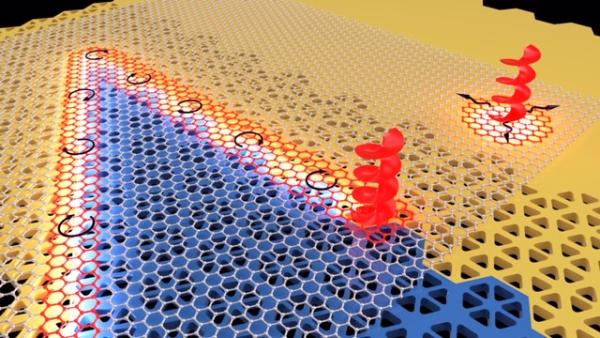
Topologically distinct photonic crystals (orange and blue) with a layer of hexagonal boron nitride on top. Image credit: Filipp Komissarenko and Sriram Guddala.
New research by a City College of New York team has uncovered a novel way to combine two different states of matter. For one of the first times, topological photons—light—has been combined with lattice vibrations, also known as phonons, to manipulate their propagation in a robust and controllable way.
The study utilized topological photonics, an emergent direction in photonics which leverages fundamental ideas of the mathematical field of topology about conserved quantities—topological invariants—that remain constant when altering parts of a geometric object under continuous deformations. One of the simplest examples of such invariants is number of holes, which, for instance, makes donut and mug equivalent from the topological point of view. The topological properties endow photons with helicity, when photons spin as they propagate, leading to unique and unexpected characteristics, such as robustness to defects and unidirectional propagation along interfaces between topologically distinct materials. Thanks to interactions with vibrations in crystals, these helical photons can then be used to channel infrared light along with vibrations.
The implications of this work are broad, in particular allowing researchers to advance Raman spectroscopy, which is used to determine vibrational modes of molecules. The research also holds promise for vibrational spectroscopy—also known as infrared spectroscopy—which measures the interaction of infrared radiation with matter through absorption, emission, or reflection. This can then be utilized to study and identify and characterize chemical substances.
“We coupled helical photons with lattice vibrations in hexagonal boron nitride, creating a new hybrid matter referred to as phonon-polaritons,” said Alexander Khanikaev, lead author and physicist with affiliation in CCNY’s Grove School of Engineering. “It is half light and half vibrations. Since infrared light and lattice vibrations are associated with heat, we created new channels for propagation of light and heat together. Typically, lattice vibrations are very hard to control, and guiding them around defects and sharp corners was impossible before.”
The new methodology can also implement directional radiative heat transfer, a form of energy transfer during which heat is dissipated through electromagnetic waves.
“We can create channels of arbitrary shape for this form of hybrid light and matter excitations to be guided along within a two-dimensional material we created,” added Dr. Sriram Guddala, postdoctoral researcher in Prof. Khanikaev’s group and the first author of the manuscript. “This method also allows us to switch the direction of propagation of vibrations along these channels, forward or backward, simply by switching polarizations handedness of the incident laser beam. Interestingly, as the phonon-polaritons propagate, the vibrations also rotate along with the electric field. This is an entirely novel way of guiding and rotating lattice vibrations, which also makes them helical.”
Entitled “Topological phonon-polariton funneling in midinfrared metasurfaces,” the study appears in the journal Science.
About the City College of New York
Since 1847, The City College of New York has provided a high-quality and affordable education to generations of New Yorkers in a wide variety of disciplines. CCNY embraces its position at the forefront of social change. It is ranked #1 by the Harvard-based Opportunity Insights out of 369 selective public colleges in the United States on the overall mobility index. This measure reflects both access and outcomes, representing the likelihood that a student at CCNY can move up two or more income quintiles. In addition, the Center for World University Rankings places CCNY in the top 1.8% of universities worldwide in terms of academic excellence. Labor analytics firm Emsi puts at $1.9 billion CCNY’s annual economic impact on the regional economy (5 boroughs and 5 adjacent counties) and quantifies the “for dollar” return on investment to students, taxpayers and society. At City College, more than 16,000 students pursue undergraduate and graduate degrees in eight schools and divisions, driven by significant funded research, creativity and scholarship. CCNY is as diverse, dynamic and visionary as New York City itself. View CCNY Media Kit.
Max Dorfman/Jay Mwamba
p: 212.650.7580
e:
jmwamba@ccny.cuny.edu